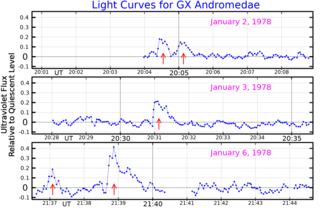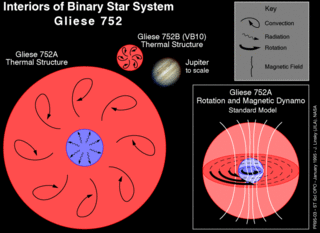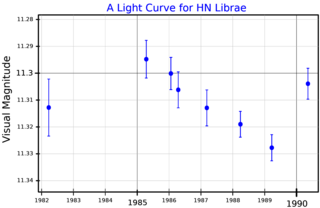Related Research Articles

Gliese 876 is a red dwarf star 15.2 light-years away from Earth in the constellation of Aquarius. It is one of the closest known stars to the Sun confirmed to possess a planetary system with more than two planets, after GJ 1061, YZ Ceti, Tau Ceti, and Wolf 1061; as of 2018, four extrasolar planets have been found to orbit the star. The planetary system is also notable for the orbital properties of its planets. It is the only known system of orbital companions to exhibit a near-triple conjunction in the rare phenomenon of Laplace resonance. It is also the first extrasolar system around a normal star with measured coplanarity. While planets b and c are located in the system's habitable zone, they are giant planets believed to be analogous to Jupiter.

Gliese 229 is a binary system composed of a red dwarf and the first brown dwarf seen by astronomers, 18.8 light years away in the constellation Lepus. The primary component has 58% of the mass of the Sun, 69% of the Sun's radius, and a very low projected rotation velocity of 1 km/s at the stellar equator.
Struve 2398 is a binary star system in the northern constellation of Draco. Struve 2398 is star number 2398 in the Struve Double Star Catalog of Russian-German astronomer Friedrich Georg Wilhelm von Struve. The astronomer's surname, and hence the star identifier, is sometimes indicated by a Greek sigma, Σ; hence, this system can be listed with the identifier Σ 2398. Although the components are too faint to be viewed with the naked eye, this star system is among the closest to the Sun. Parallax measurements by the Gaia spacecraft give them an estimated distance of 11.5 light-years away.

Groombridge 34 is a binary star system in the northern constellation of Andromeda. It was listed as entry number 34 in A Catalogue of Circumpolar Stars, published posthumously in 1838 by British astronomer Stephen Groombridge. Based upon parallax measurements taken by the Gaia spacecraft, the system is located about 11.6 light-years from the Sun. This positions the pair among the nearest stars to the Solar System.
Gliese 674(GJ 674) is a small red dwarf star with an exoplanetary companion in the southern constellation of Ara. It is too faint to be visible to the naked eye, having an apparent visual magnitude of 9.38 and an absolute magnitude of 11.09. The system is located at a distance of 14.8 light-years from the Sun based on parallax measurements, but is drifting closer with a radial velocity of −2.9 km/s. It is a candidate member of the 200 million year old Castor stream of co-moving stars.
Gliese 581 is a red dwarf star of spectral type M3V at the center of the Gliese 581 planetary system, about 20.5 light years away from Earth in the Libra constellation. Its estimated mass is about a third of that of the Sun, and it is the 101st closest known star system to the Sun. Gliese 581 is one of the oldest, least active M dwarfs known. Its low stellar activity improves the likelihood of its planets retaining significant atmospheres, and lessens the sterilizing impact of stellar flares.
Gliese 849, or GJ 849, is a small, solitary star in the equatorial constellation of Aquarius. It has a reddish hue and is invisible to the naked eye with an apparent visual magnitude of 10.41. The distance to this star is 28.8 light-years based on parallax, but it is drifting closer to the Sun with a radial velocity of −15.3 km/s. It has a pair of confirmed gas giant companions.
Gliese 832 is a red dwarf of spectral type M2V in the southern constellation Grus. The apparent visual magnitude of 8.66 means that it is too faint to be seen with the naked eye. It is located relatively close to the Sun, at a distance of 16.2 light years and has a high proper motion of 818.16 milliarcseconds per year. Gliese 832 has just under half the mass and radius of the Sun. Its estimated rotation period is a relatively leisurely 46 days. The star is roughly 6 billion years old.
Gliese 86 is a K-type main-sequence star approximately 35 light-years away in the constellation of Eridanus. It has been confirmed that a white dwarf orbits the primary star. In 1998 the European Southern Observatory announced that an extrasolar planet was orbiting the star.
Gliese 176 is a red dwarf in the constellation of Taurus. Based upon parallax measurements from the Hipparcos mission, it is located 31 light-years away. The star is orbited by a Super-Earth.

Gliese 752 is a binary star system in the Aquila constellation. This system is relatively nearby, at a distance of 19.3 light-years.
Gliese 433 is a dim red dwarf star with multiple exoplanetary companions, located in the equatorial constellation of Hydra. The system is located at a distance of 29.6 light-years from the Sun based on parallax measurements, and it is receding with a radial velocity of +18 km/s. Based on its motion through space, this is an old disk star. It is too faint to be viewed with the naked eye, having an apparent visual magnitude of 9.81 and an absolute magnitude of 10.07.
Gliese 521 is a double star in the northern constellation of Canes Venatici. The system is located at a distance of 43.6 light-years from the Sun based on parallax measurements, but is drawing closer with a radial velocity of −65.6 km/s. It is predicted to come as close as 15.70 light-years from the Sun in 176,900 years. This star is too faint to be visible to the naked eye, having an apparent visual magnitude of +10.26 and an absolute magnitude of 10.24.
Gliese 146 is a K5V class star located in the constellation Horologium. At 44.4 light years, GJ 146 has an apparent magnitude of +8.57. Gliese 146 is also known as HD 22496, HIP 16711, SAO-216392, and LHS 1563.
Gliese 163 is a faint red dwarf star with multiple exoplanetary companions in the southern constellation of Dorado. Other stellar catalog names for it include HIP 19394 and LHS 188. It is too faint to be visible to the naked eye, having an apparent visual magnitude of 11.79 and an absolute magnitude of 10.91. This system is located at a distance of 49.4 light-years from the Sun based on parallax measurements. Judging by its space velocity components, it is most likely a thick disk star.

Gliese 180, is a small red dwarf star in the equatorial constellation of Eridanus. It is invisible to the naked eye with an apparent visual magnitude of 10.9. The star is located at a distance of 39 light years from the Sun based on parallax, and is drifting closer with a radial velocity of −14.6 km/s. It has a high proper motion, traversing the sky at the rate of 0.765 arcseconds per year.
Gliese 251, also known as HIP 33226 or HD 265866, is a star located about 18 light years away from the Solar System. Located in the constellation of Gemini, it is the nearest star in this constellation. It is located near the boundary with Auriga, 49 arcminutes away from the bright star Theta Geminorum; due to its apparent magnitude of +9.89 it cannot be observed with the naked eye. The closest star to Gliese 251 is QY Aurigae, which is located 3.5 light years away.

Gliese 555, also known as HN Librae, is a red dwarf star of spectral type M4.0V, located in the constellation Libra at a distance of 20.4 light-years from Earth.
Gliese 328, also known as BD+02 2098, is a M-type main-sequence star located 66.9 light-years away in the constellation Hydra. Its surface temperature is 3989 K. Gliese 328 is depleted in heavy elements compared to the Sun, with a metallicity Fe/H index of −0.13. The age of the star is unknown. Gliese 328 exhibits an activity cycle similar to that of the Sun, with a period around 2000 d.
Gliese 514, also known as BD+11 2576 or HIP 65859, is a M-type main-sequence star, in the constellation Virgo 24.85 light-years away from the Sun. The proximity of Gliese 514 to the Sun was known exactly since 1988.
References
- 1 2 3 4 5 6 Vallenari, A.; et al. (Gaia collaboration) (2023). "Gaia Data Release 3. Summary of the content and survey properties". Astronomy and Astrophysics. 674: A1. arXiv: 2208.00211 . Bibcode:2023A&A...674A...1G. doi: 10.1051/0004-6361/202243940 . S2CID 244398875. Gaia DR3 record for this source at VizieR.
- 1 2 3 4 5 6 7 8 9 10 Pinamonti, M.; Barbato, D.; et al. (June 2023). "The GAPS programme at TNG. XLVI. Deep search for low-mass planets in late-dwarf systems hosting cold Jupiters". Astronomy & Astrophysics . 677. arXiv: 2306.04419 . Bibcode:2023A&A...677A.122P. doi:10.1051/0004-6361/202346476. S2CID 259095781.
- 1 2 3 4 Pineda, J. Sebastian; Youngblood, Allison; France, Kevin (September 2021). "The M-dwarf Ultraviolet Spectroscopic Sample. I. Determining Stellar Parameters for Field Stars". The Astrophysical Journal. 918 (1): 23. arXiv: 2106.07656 . Bibcode:2021ApJ...918...40P. doi: 10.3847/1538-4357/ac0aea . S2CID 235435757. 40.
- ↑ Johnson, John Asher; et al. (2010). "The California Planet Survey II. A Saturn-Mass Planet Orbiting the M Dwarf Gl649". The Publications of the Astronomical Society of the Pacific. 122 (888): 149–155. arXiv: 0912.2730 . Bibcode:2010PASP..122..149J. doi:10.1086/651007. S2CID 119254409.
- 1 2 Kennedy, Grant M.; et al. (2018). "Kuiper Belt Analogues in Nearby M-type Planet-host Systems". Monthly Notices of the Royal Astronomical Society. 476 (4): 4584–4591. arXiv: 1803.02832 . Bibcode:2018MNRAS.476.4584K. doi:10.1093/mnras/sty492. S2CID 62879401.